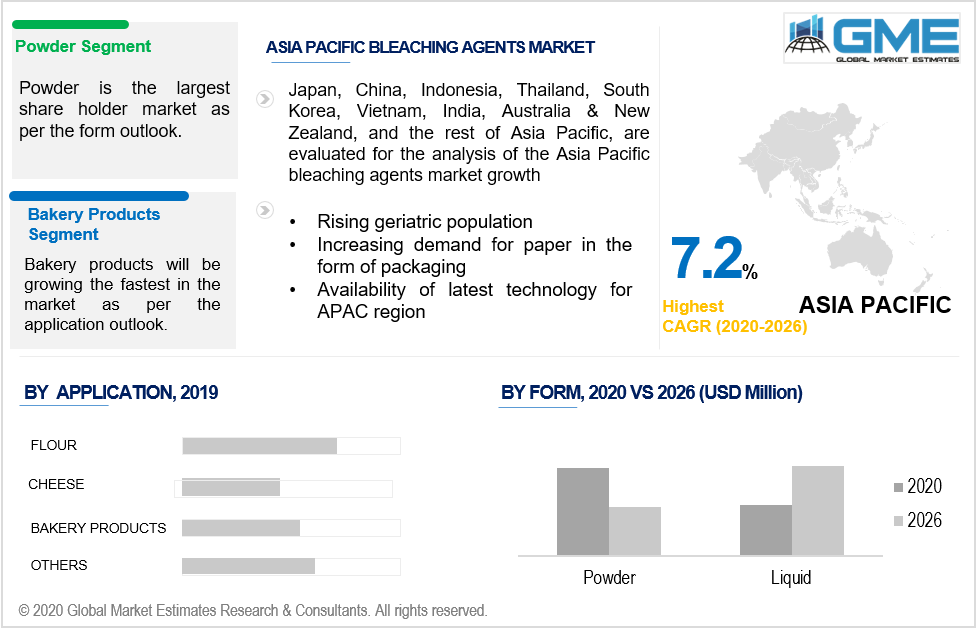
Global Bleaching Agents Market Size, Trends & Analysis with COVID-19 Impact - Forecasts To 2026 By Type (Ascorbic Acid, Acetone Peroxide, Azodicarbonamide, Chlorine Dioxide, Hydrogen Peroxide, Acetone Peroxide, Others), By Form (Powder, Liquid), By Application (Flour, Bakery Products, Cheese, Others), By Region (North America, Europe, Asia Pacific and Rest of the World); and Company Market Share Analysis & Competitor Analysis
A higher compound annual growth rate would increase global demand for bleaching agents in the projected period from 2020 to 2026. The bleaching agent is a substance that lightens or whitens the substrate through chemical reactions. The bleaching reactions extensively involves the process of oxidation or reduction, which in turn degrades the color structures. Some of the major reasons projected to raise demand for bleaching agents are the increased demand for water treatment, along with the growing demand from the pulp & paper industry. Moreover, the increase in bread consumption and related products from bakeries is also steering the industry's growth. Furthermore, the factors affecting the growth of the market in the forecast period are major technological developments for product evaluation coupled with increasing food industry technologies. However, stringent regulations on the environment and the toxicity of bleaching agents, are likely to adversely hinder the market growth during the projected era.

The sector is categorized into form-based segments: powder, and liquid. The powder division is expected to contribute more to worldwide consumer sales in all forms. This is attributable to the advances in technology that have led to increased use of powdered bleaching agents as the dosage is simpler than the liquid form. The powdered form of bleaching agents has a longer shelf life, like ascorbic acid, potassium bromate, and hydrogen peroxide, and is generally stable at room temperature for so many years.
According to the agent type study, this market may be represented in seven categories, namely: ascorbic acid, acetone peroxide, azodicarbonamide, chlorine dioxide, hydrogen peroxide, and acetone peroxide, among others. The hydrogen peroxide segment division is projected to contribute more to the worldwide revenue of the sector across all types. It is widely used as a peroxygen agent in products such as rice, baking foods, natural sugars, natural oils, waxes, gums, and starches in the food & beverage manufacturing industry. Hydrogen peroxide, for the most part, bleaches and purifies food products, which in effect helps to enhance the color of food products.
Depending on the application, this market can be represented in four areas, including flour, bakery products, and cheese, among others. It was anticipated that the demand for the application of the flour segment would contribute more to global revenues in this business area. Because of the rising urban population, increasing disposable income, and evolving people's lifestyles, conventional at-home meals are gradually being replaced with on-the-go breakfast snacks and meals. Bleaching of flour helps in a reduced amount of time to weaken the proteins and mature the flour and has thus become a necessity for producers of flour. For whitening flour, bleaching agents are used as freshly milled flour has a slightly yellowish color because it contains carotenoids.

The demand for bleaching agents, based on the geographical area, is divided into Europe, North America, Asia Pacific, CSA, and the Middle East and Africa. Over the coming years, the North American region is projected to contribute to worldwide revenues. This is due to the high chlorine-based bleaching agent use and increasing government investments in wastewater treatment plants which are boosting the demand in the region. The Asia-Pacific region is also planned to see strong growth in developing countries at a robust CAGR rate. The rising construction industry, along with the increase in demand for hydrogen peroxide from pulp & paper and chemical industries in countries like India and China are some of the reasons that affect the growth of the industry.
The key players competing in this market are BASF, Evonik, AkzoNobel, Siemer Milling, Supraveni Chemicals, Engrain, Aditya Birla Chemicals (Grasim), Solvay, Hawkins, Inc., Peroxychem, Spectrum Chemicals, and Gujarat Alkalies & Chemicals, among others.
Please note: This is not an exhaustive list of companies profiled in the report.
In February 2020, Peroxychem was acquired by Evonik Industries AG for USD 640 million. PeroxyChem is a producer of peracetic acid (PAA) and hydrogen peroxide (H2O2).
We value your investment and offer free customization with every report to fulfil your exact research needs.
The Global Bleaching Agents Market has been studied from the year 2017 till 2026. However, the CAGR provided in the report is from the year 2018 to 2026. The research methodology involved three stages: Desk research, Primary research, and Analysis & Output from the entire research process.

The desk research involved a robust background study which meant referring to paid and unpaid databases to understand the market dynamics; mapping contracts from press releases; identifying the key players in the market, studying their product portfolio, competition level, annual reports/SEC filings & investor presentations; and learning the demand and supply side analysis for the Bleaching Agents Market.

The primary research activity included telephonic conversations with more than 50 tier 1 industry consultants, distributors, and end-use product manufacturers.

Finally, based on the above thorough research process, an in-depth analysis was carried out considering the following aspects: market attractiveness, current & future market trends, market share analysis, SWOT analysis of the companies and customer analytics.

Tailor made solutions just for you
80% of our clients seek made-to-order reports. How do you want us to tailor yours?
OUR CLIENTS